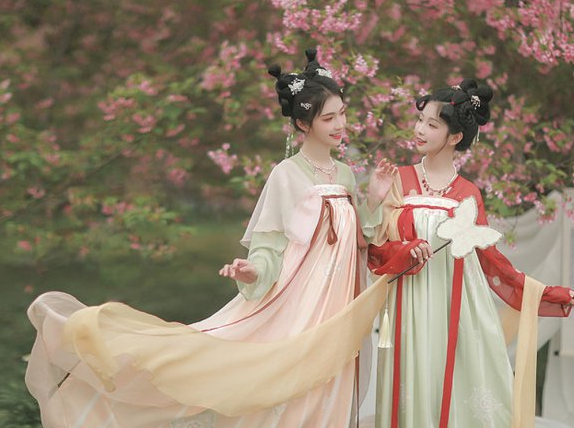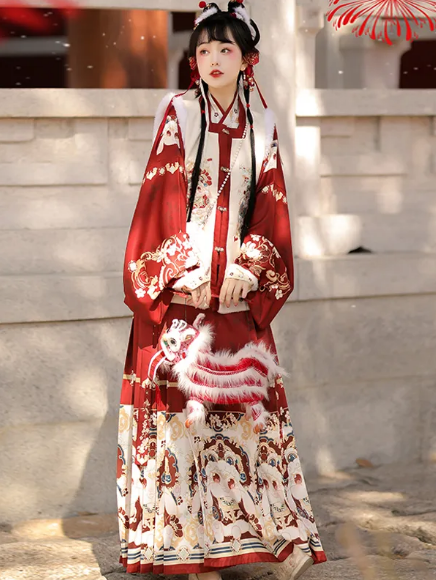To choose the right Hanfu for different seasons, consider the fabric’s weight, seasonal colors, and layering for comfort.
Understanding Hanfu Varieties
Hanfu, the traditional Chinese attire, mirrors the rich tapestry of China’s history. Its evolution through various dynasties brings to life a vibrant cultural legacy.
Historical Background of Hanfu
The journey of Hanfu begins in the Han Dynasty, marking it as a cultural icon. It captures the essence of each era: the Tang Dynasty’s Hanfu dazzles with vibrant colors, echoing the Silk Road’s influence, while the Ming Dynasty’s designs focus on elegance and simplicity, reflecting a more introspective cultural mood.

Types of Hanfu and Their Characteristics
In the realm of Hanfu, each style tells a story. The ‘Ruqun’, combining a blouse and a wrap-around skirt, is a staple for its elegance. The ‘Shenyi’, a unified garment, symbolizes harmony and modesty. For everyday comfort, the ‘Zhiju’, with its straight lines and relaxed fit, is a popular choice.
Material choices in Hanfu reflect both practical and aesthetic considerations. Silk and gauze, light and airy, are the go-to fabrics for summer, ensuring coolness in the heat. Conversely, winter Hanfu often features heavier materials like brocade and wool, providing warmth and showcasing intricate designs.
Color plays a significant role too. Spring Hanfu often blooms in pastel shades, mimicking the season’s gentle beauty. Autumn, on the other hand, sees a shift to warmer, deeper hues, mirroring the changing leaves.
Patterns in Hanfu also hold meaning. Floral designs, common in spring and summer, represent growth and vitality. Winter patterns might feature more geometric shapes, symbolizing stability and endurance through the colder months.
In every thread and fold of Hanfu, there lies a deep connection to the land, the climate, and the enduring spirit of Chinese culture. This attire is not just a garment but a living, evolving story of a civilization.
Seasonal Considerations in Hanfu Selection
Selecting Hanfu according to the season is a vital part of embracing this traditional attire. It involves considering the climate, cultural events, and fashion trends of each season.
Spring and Summer Hanfu Styles
During spring and summer, Hanfu enthusiasts often prefer lightweight fabrics like silk, linen, and thin cotton. These materials offer breathability and comfort in warmer weather. In terms of design, spring Hanfu often features vibrant floral patterns, reflecting the season’s fresh bloom. Summer styles tend to favor lighter colors such as pastels, which reflect sunlight and keep the wearer cool. The typical summer Hanfu might include a ‘Ruqun’ with a sheer, flowing skirt and a light, short-sleeved blouse.
Autumn and Winter Hanfu Fabrics and Designs
In contrast, autumn and winter call for Hanfu made from heavier fabrics like wool, brocade, and thick cotton to provide warmth. These seasons also see a shift in color palettes to deeper, richer hues like reds, golds, and dark greens, echoing the colors of autumn leaves and winter’s subdued tones. Winter designs might include layers, such as a warm undergarment beneath a heavier, decorative overcoat. Embroideries in these seasons often depict traditional symbols like pine trees or snowflakes, aligning with the themes of endurance and the serene beauty of winter.
Throughout the year, the selection of Hanfu is not just about aesthetic appeal but also about practicality and comfort. It reflects a deep understanding of the changing seasons and an appreciation for how traditional attire can adapt to modern lifestyles while retaining its cultural essence. This approach to Hanfu selection ensures that the tradition remains relevant and cherished in contemporary society.
Color and Pattern Choices for Different Seasons
The selection of colors and patterns in Hanfu plays a crucial role in aligning traditional attire with the changing seasons. This choice reflects not just aesthetic preferences but also cultural and historical influences.
Spring and Summer Color Palettes
In spring, Hanfu celebrates the rejuvenation of nature with vibrant and fresh colors. Soft pinks, gentle greens, and sky blues dominate, echoing the blossoming flowers and clear skies. Summer introduces more vivid shades, like bright yellows and bold reds, reflecting the energy and warmth of the season. These colors not only resonate with the season’s liveliness but also enhance the wearer’s comfort by reflecting sunlight rather than absorbing it.
Autumn and Winter Pattern Selections
Autumn Hanfu shifts to a palette of golden, orange, and deep red, mirroring the season’s changing leaves. The patterns in autumn often feature motifs such as falling leaves or harvest symbols, celebrating the season’s bounty. Winter, in contrast, sees a preference for cooler colors like icy blues and greys, often paired with patterns depicting snowflakes or plum blossoms, symbolizing perseverance and the promise of spring. The use of such colors and patterns in Hanfu not only provides visual warmth but also carries deep cultural significance, celebrating the beauty and symbolism of each season.
These color and pattern choices in Hanfu are more than mere fashion statements. They are a testament to the enduring relationship between culture and nature, reflecting how traditional attire can adapt to modern sensibilities while preserving its rich heritage. The careful selection of these elements in Hanfu underscores the profound respect for nature and cultural traditions that have shaped Chinese society for centuries.

Practical Tips for Wearing Hanfu in Various Seasons
Wearing Hanfu appropriately across different seasons involves more than just choosing the right fabric and color. It’s about balancing comfort, elegance, and cultural authenticity.
Adapting Hanfu for Comfort and Elegance
In warmer months, opting for Hanfu made from lightweight materials like silk or linen can maximize comfort without sacrificing elegance. These fabrics allow the skin to breathe and facilitate air circulation, essential for staying cool. For colder seasons, layering is key. Start with a thinner base layer, possibly made of thermal materials, and top it with thicker Hanfu pieces. This method keeps you warm while allowing flexibility and movement.
When it comes to fitting, ensure that the Hanfu sits comfortably on your body. It should be loose enough to allow easy movement but structured enough to maintain its traditional form. The wrap-around skirts or trousers should have adjustable closures to accommodate different body shapes and sizes, ensuring a perfect fit for everyone.
Accessorizing Hanfu for Seasonal Appropriateness
Accessories play a significant role in adapting Hanfu for different seasons. In spring and summer, complement your Hanfu with light and airy accessories like silk fans or floral hairpins. These not only add to the aesthetic but also enhance practicality in the heat. For autumn and winter, consider adding embroidered scarves or fur-lined cloaks. These add layers of warmth and can be easily removed as needed.
Footwear should also match the season. Light, breathable shoes are ideal for warmer months, while closed, warmer boots suit the colder seasons. The goal is to balance traditional aesthetics with practical, modern needs.
By considering these practical aspects, wearing Hanfu becomes a comfortable and enjoyable experience, allowing you to celebrate Chinese cultural heritage in style, regardless of the season. This approach to wearing Hanfu not only respects its historical significance but also ensures it remains a relevant and cherished part of contemporary fashion.







